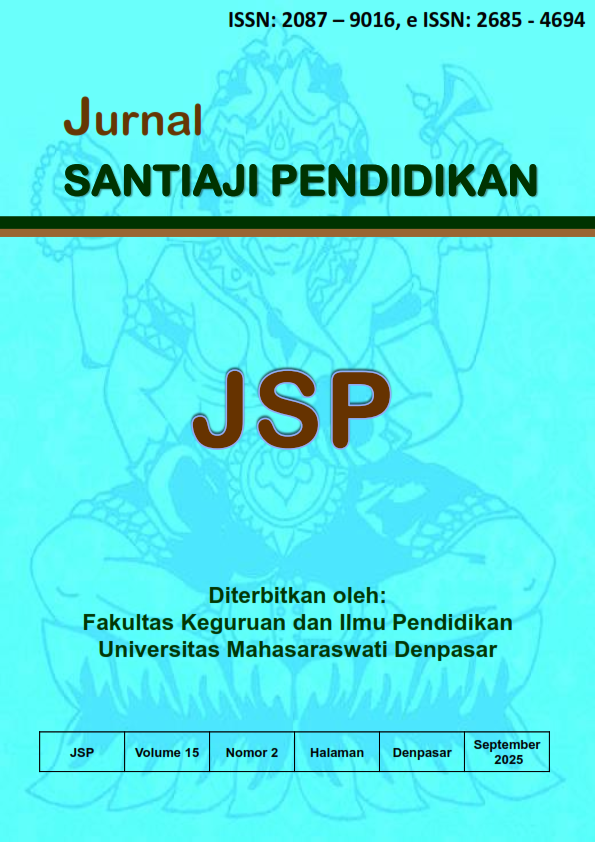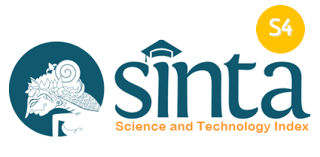EXPLORING EFL STUDENTS' PERCEPTIONS AND CHALLENGES IN INTEGRATING RECIPROCAL TEACHING AND COMMUNICATIVE LANGUAGE TEACHING
DOI:
https://doi.org/10.36733/jsp.v15i2.12383Keywords:
Communicative Language Teaching, Challenges, Perception, Reciprocal TeachingAbstract
In today's global world, reading and speaking English well is a key skill for helping students do well in class. Learning methods can affect how well students learn in places where English is a foreign language (EFL). This study aims to determine how EFL students feel about and deal with the difficulties of combining two popular language teaching methods, Reciprocal Teaching (RT) and Communicative Language Teaching (CLT), in higher education institutions. A mixed-methods approach was used to gather data from English Language Education Study Program students. This included observations, questionnaires, and interviews. The results show that most students think combining RT and CLT is a good way to help them understand what they read, speak fluently, and learn with others. RT strategies help make predictions, ask questions, clarify, and summarize texts. CLT, on the other hand, promotes real-life communication activities like group discussions and role-playing. Students also expressed a preference for interactive, contextual, and collaborative learning. But this study also found several challenges, such as insufficient time to learn, anxiety when speaking and a tendency for some students to prefer independent learning. Cultural factors, learning styles, and support affect students' involvement and reactions to both approaches. These findings contribute to developing more effective, student-centred, and relevant English language learning.
Downloads
References
Abdelmoati Mohamed, R. A. (2023). Reciprocal Teaching as a Cognitive and Metacognitive Strategy in Promoting Saudi University Students’ Reading Comprehension. Open Education Studies, 5(1). https://doi.org/10.1515/edu-2022-0200
Abrori, A., Hifdil Islam, M., & Hamdani, B. (2023). The Effectiveness of Reciprocal Teaching Method on Students’ Reading Comprehension in Descriptive Text. JADEs Journal of Academia in English Education, 4(1), 71–88. https://doi.org/10.32505/jades.v4i1.5755
Choo, T. O. L., Eng, T. K., & Ahmad, N. (2011). Effects of Reciprocal Teaching Strategies on Reading Comprehension. Reading Matrix: An International Online Journal, 11(2), 140–149. Retrieved from http://search.proquest.com/docview/964185062?accountid=14391
Creswell, J. W. (2012). Educational research: Planning, conducting and evaluating quantitative and qualitative research (4th ed.). Boston: Pearson Education, Inc.
Göer, A. (2010). A comparative research on the effectivity of cooperative learning method and jigsaw technique on teaching literary genres. Educational Research and Reviews, 5(8), 439–445.
Harmer, J. (2010). The Practice of Language Teaching. Longman Handbooks for Language Teaching Series, p. 386. Retrieved from https://www.academia.edu/25472823/The_Practice_of_English_Language_Teaching_4th_Edition_Jeremy_Harmer
Herlina, N., Hilir, R., & Pengarayaan, P. (2017). the Use of Reciprocal Strategy in Teaching Reading Comprehension. Proceedings of the Fifth International Seminar on English Language and Teaching, 105–112.
Hermansyah, S., Asrifan, A., Nadirah, N., & Imran, I. (2022). The Use Of Reciprocal Teaching Procedure In Teaching Recount Text To Improve Students Reading Comprehension. La Ogi : English Language Journal, 8(2), 177–182. https://doi.org/10.55678/loj.v8i2.683
Jiang, L., & Paulino, F. B. (2024). Rethinking Communicative Language Teaching in College English Teaching: Strategies and Lesson Plan. Journal of Language Teaching and Research, 15(2), 607–616. https://doi.org/10.17507/jltr.1502.29
Kadwa, M. S., & Alshenqeeti, H. (2020). Impact of Communicative Language Teaching Method on Students’ Speaking and Listening Skills: A Review Article. International Journal of Linguistics, Literature and Translation (IJLLT), 3(11), 55–67. https://doi.org/10.32996/ijllt
Kagan, S., & Kagan, M. (2009). Why Do We Need Cooperative Learning? In Kagan Cooperative Learning.
Kayi, H. (2006). Teaching Speaking: Activities to Promote Speaking in a Second Language. The Internet TESL Journal, XII(11), pg 1. Retrieved from http://www.iteslj.org
Koşar, G., & Akbana, Y. E. (2021). The Impact of Reciprocal Teaching on Pre-Service English-as-a-Foreign-Language Teachers’ Reading Comprehension Skills. Dil Eğitimi ve Araştırmaları Dergisi, 7(2), 280–294. https://doi.org/10.31464/jlere.857504
Krismayani, N. W., Joni, D. A. A. W., & Budiarta, I. K. (2023). Developing Addie Model: Speaking for Informal Interaction Based on OBE Curriculum. VELES: Voices of English Language Education Society, 7(1), 12–22. https://doi.org/10.29408/veles.v7i1.7273
Menggo, S., Merlyna Yuda Pramesti, P. D., & Krismayani, N. W. (2023). Integrating Project-Based Learning in Preparing Students’ Interpersonal Communication Skills on Speaking Courses in Indonesia. International Journal of Learning, Teaching and Educational Research, 22(9), 219–240. https://doi.org/10.26803/ijlter.22.9.12
Pamuji, A., Wahyudi, A., Martuti, R., Bina, S., & Palembang, H. (2024). Pelatihan Communicative Language Teaching (Clt) Untuk Meningkatkan Kemampuan Komunikasi Berbahasa Inggris Mahasiswa Kebidanan Stik Bina Husada. CARE: Journal Pengabdian Multi Disiplin, 2(1), 23–31. Retrieved from http://journal.universitaspahlawan.ac.id/index.php/care/article/view/24932%0Ahttp://journal.universitaspahlawan.ac.id/index.php/care/article/download/24932/17639
Ratama, I. P., Padmadewi, N. N., & Artini, L. P. (2021). Teaching the 21st century skills ( 4Cs ) in English literacy activities. Journal of Educational Research and Evaluation, 5(2), 223–233.
Richards, J. C., & Rodgers, T. S. (2014). Approaches and methods in language teaching (3rd ed.). Cambridge: Cambridge University Press. https://doi.org/10.1093/elt/ccw083
Rojabi, A. R. (2021). Exploring Reciprocal Teaching Method on EFL Learners’ Reading Comprehension. VELES Voices of English Language Education Society, 5(2), 132–142. https://doi.org/10.29408/veles.v5i2.3860
S, I., Mujahidah, M., & Asni, Y. (2023). Effectiveness of Communicative Language Teaching (Clt) Method To Improve Students Speaking Skill. Al-Irsyad: Journal of Education Science, 2(2), 161–167. https://doi.org/10.58917/aijes.v2i2.79
Setiyorini, T. J., Yulia, Y., & Robiasih, H. (2022). Communicative language teaching method at improving students’ macro and micro-skills of reading comprehension in intensive reading course. EduLite: Journal of English Education, Literature and Culture, 7(2), 233. https://doi.org/10.30659/e.7.2.233-250
Sitosanova, O. (2021). Communicative Approach in Foreign Language Teaching. Modern Technologies and Scientific and Technological Progress, 1(1), 367–368. https://doi.org/10.36629/2686-9896-2021-1-1-367-368
Taka, S. D. (2020). The Efficacy of Using Reciprocal Teaching Technique in Teaching Reading to Indonesian English as Foreign Language (EFL) Students. IDEAS: Journal on English Language Teaching and Learning, Linguistics and Literature, 8(1), 197–206. https://doi.org/10.24256/ideas.v8i1.1345
Wu, T.-T., De Haviland Basoeki, O., & Huang, Y.-M. (2024). The Impact of Reciprocal Collaborative Pedagogy in ESP Reading Comprehension Skills: Reducing Anxiety and Improving Self-Efficacy. https://doi.org/10.20944/preprints202401.1138.v1
Yuniarti, Rufinus, A., & Wijaya, B. (2014). The Use of Reciprocal Questioning (Request) Strategy in Teaching Reading Comprehension. Jurnal Pendidikan Dan Pembelajaran Khatulistiwa, 3(2), 1–7. Retrieved from http://dx.doi.org/10.26418/jppk.v3i2.4648
Downloads
Published
Issue
Section
License
Copyright (c) 2025 Ni Wayan Krismayani Krismayani, I Komang Budiarta, Ni Luh Dian Sawitri, Ni Putu Leyen Hartika, Ni Komang Aryanti Mahottami

This work is licensed under a Creative Commons Attribution 4.0 International License.











